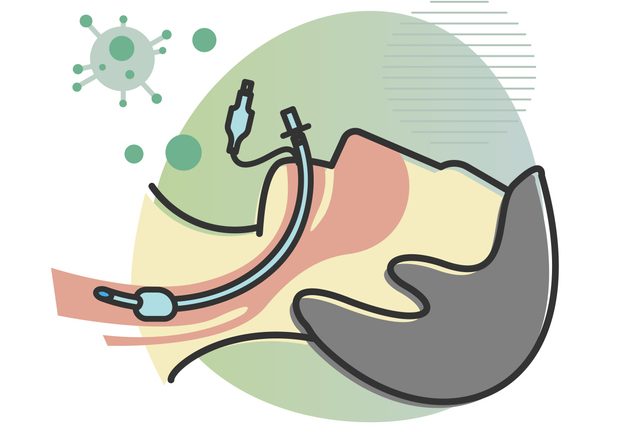Key events of the essential lifesaving tool.
Modern endotracheal tubes, airway protective devices, which promote safe passage of a wide array of gases in both medical and surgical settings, have a colorful history of development. Centuries of innovation, trial and error have created our current endotracheal airway technology. The journey began thousands of years ago when humans developed a cause and method of accessing airways. Tracheotomy practices have been recorded as early as 3600 BC according to some Egyptian tablets.[1]
Ancient Greece, India and Rome all followed suit with their own documentations of tracheotomy accords riddled throughout historical records, including one of the more popular stories involving Alexander the Great (356 – 323 BCE). According to Homerus of Byzantium, Alexander once witnessed a soldier suffocating on the battlefield. Thinking swiftly, Alexander plunged the tip of his sword into the soldiers trachea, creating an incision wide enough for the passage of air and saving the soldier from certain asphyxiation.[1] While Alexander’s surgical credentials and feats are open for debate, the idea remains that ancient tracheotomies were the sole means of airway access and management for hundreds of years.
The Greek philosopher Hippocrates (460 – 380 BCE) described a method of tracheal intubation for humans to support ventilation.[2] However, it wasn’t until the 16th century when Andreas Vesalius (1514–1564), a Renaissance physician who illustrated and authored the first comprehensive textbook of anatomy, became the earliest recorded pioneering practitioner of tracheal intubation.[4] Andreas was practicing pneumothorax models on pigs and needed a way to maintain lung pressures after the thoracic cavity had been breached.
In 1543, Andreas Vesalius performed a tracheotomy on a pig, inserted a tube of reed or cane into the pig’s trachea, began a thoracotomy and blew down the tube to provide artificial ventilation. [3] Much to his delight, Andreas’s method was successful in preventing lung collapse. Little to his knowledge, Andreas had just created an innovation that would change the scope of medicine forever.
Chelmsford surgeon Benjamin Pugh created an ‘air pipe’ made from coiled wire wrapped in leather in 1754. Pugh’s ‘air pipe’ was introduced orally and blindly into the trachea of an asphyxiated neonate while an operator intermittently blew down the tube to provide breaths. The technique was relatively successful, but many doubted its practicality due to high incidences of trauma when blindly introducing the tube. [3]
Charles Kite, a Gravesend surgeon, was credited in 1788 with saving many from drowning in the Thames. He was able to insufflate and resuscitate his patients with the help of a curved metal cannula which he blindly introduced into the trachea. In 1807, Chaussier, a physician to the Maternite de Paris, created his own curved metal cannula with a sponge collar near the tip to ensure a tight fit. [1]
As tracheal intubations gained popularity, the needs grew as well. In an effort to reduce incidences of trauma when introducing orotracheal tubes, Benjamin Guy Babington created a ‘Glottiscope’ in 1828 so that the trachea could be observed when attempting an orotracheal intubation. [2] While the Glottiscope did not immediately gain the popularity it deserved, it provided framework for laryngoscopy, which would be capitalized upon in the following century.
In the 19th century, the idea of an airtight seal became more popular in an effort to reduce aspiration during upper respiratory tract surgeries. Experimenting with Chaussier’s design, DePaul (1845) and Ribemont (1858) created their own tubes with sponge collars or conical tips, which ultimately paved the way for Friedrich Trendelenberg to create the first tube with an inflatable cuff in 1869. [3] However, Trendelenberg’s tube required a tracheotomy as reliable laryngoscopy was still not a mainstay yet.
William Macewin, the first physician to administer an anesthetic through an orotracheal tube, and many others appreciated the idea of inflatable cuffs, but advocated against Trendelenberg’s tracheotomy practices. Thus, metal orotracheal tubes with sponge cuffs were a mainstay of practice until the late nineteenth century when Eisenmenger created a metal orotracheal tube with an inflatable rubber cuff. [1]
Despite the growing popularity of orotracheal tubes in the 19th century, tracheotomies were still widely used as management of asphyxiating conditions. However, in 1885 Joseph O’Dwyer presented a laryngeal intubation method, which was met with high praise for the management of pediatric Diphtheric Croup.
Additionally, O’Dwyer is credited as one of the first to connect a foot bellows to his metal endotracheal tubes to prevent pulmonary collapse during a thoracotomy [3]. As a result of these revolutions, morbidity and mortality rates from Diphtheria significantly decreased and orotracheal intubation began to overtake tracheotomy as a means of airway management.
Due to availability of materials, most endotracheal tubes up until the 20th century were made from metal, which added to the potential for trauma during use. However, with the second industrial revolution came a flurry of new plastics and rubbers. As a result, in 1900 Franz Kuhn created a malleable endotracheal tube from a wire spiral with a rubber insertion, which was similar in nature to the original ‘air pipe’ created by Benjamin Pugh in 1754. [1]
Despite softer and more malleable tubes, the major obstacle remained of safely passing endotracheal tubes through the vocal cords reliably and safely. Babington attempted to remedy this with his Glottiscope in 1828, but the need for direct visual laryngoscopy wasn’t fully appreciated until mass cranio-facial trauma during World War I. Rowbotham and Magill, both from the British Army plastics unit, made efforts with their tubes and cuffs, but the necessary revelation came in 1920 from Chevalier Jackson and his updated laryngoscope technology. [2,3]
Suddenly, with rubber endotracheal tubes and laryngoscopes, the stage was set for widespread use and further development of endotracheal technology. Gale, Waters, Leatherdale, Vellacott and many others all made their contributions over the next few decades to help create the wide array of endotracheal tubes which we appreciate and use today. [2,3]
In 1941, Robert Miller created a laryngoscope with a curved tip to hold back the epiglottis and Sir Robert Macintosh contributed his famous curved blade design, both of which are still regularly used today. [2] Rubber was replaced with plastic for tube material in the 1960s and the modern cuffed endotracheal tube design came to light.
The development of the modern endotracheal tube was a long exciting process and the previous key events are only a brief glimpse into the colorful whole story. Undoubtedly, endotracheal intubation has defined itself as an essential tool in the practices of modern medicine that helps save countless lives every day.
Timeline
1754 – Pugh creates his ‘air pipe’. It is a difficult to manage tool and not widely accepted due to instances of traumatic insertion.
1788 – Kite uses his curved metal cannula to save drowning patients in the Thames.
1807 – Chassieur uses a curved metal tube with sponge collar to ensure a tight fit. Similar designs by Depaul (sponge collar) in 1845 and Ribemont in 1858 (conical tip for air tight seal).
1828 – Benjamin Guy Babington created his ‘glottiscope.’
Early 19th Century Problem – Post operative pneumonia was common after upper respiratory tract surgeries. This was eventually solved with creation and acceptance of tubes utilizing inflatable cuffs and sponge collars to prevent aspiration.
1869 – Trendelenberg created his tube with inflatable cuff. It was successful in preventing aspiration, but required tracheotomy, as laryngoscopy and orotracheal intubation were not mainstays yet.
1880 – Macewin created his orotracheal tube with a sponge collar to prevent aspiration, which was introduced orally by touch. He was also the first to give anesthetic through orotracheal tube.
1887 – O’Dwyer gained fame for using metal laryngeal tubes in cases of diphtheric croup.
Nineteenth Century Problem – Pulmonary collapse during thoracotomies.
1888 – O Dwyer improved on his design and added a conical end to his tubes for an airtight seal. Then, using a foot pedal invented by Fell of Buffalo, he raised intra tracheal pressure and prevented pulmonary collapse during thoracotomies.
1893 – Eisenmenger is credited as first to use inflatable cuff attached to an orotracheal tube.
1900 – Franz Kuhn creates a malleable tube from rubber and wire to help prevent traumatic insertion.
1907 – Barthelemy and Dufour of Nancy create thin endotracheal tubes for insufflation, which replaced wide bore tubes for inhalation.
1909 – Meltzer and Auer, NY physiologists, supported the insufflation model and claimed expired gases would prevent aspiration (Kuhn never advocated for this idea).
Twentieth Century Problem – Intubations are too difficult to make endotracheal anesthesia widely popular.
1910 – Kirstein advocates for direct laryngoscopic intubation with Kirstein Autoscope. It was not widely accepted because the technique was difficult.
1914-1918 – War left many people needing plastic surgery on their head and neck. It made for more popular use of endotracheal intubation. Rowbotham created a wide bore tube with a laryngeal cuff and Magill follows suit with a widebore tube with a tracheal cuff. Both worked with British army plastics unit.
1920 – Direct laryngoscopic intubation more widely accepted due to improved laryngoscope created by Chevalier Jackson.
1926 – Ideas of insufflation rejected by Magill and Rowbotham in Europe and by Waters and Flagg in America in 1927.
1932 – Gale and Waters create Endobronchial tubes first used for anesthesia. Tube was rubber and molded in hot water.
1936 – Magill developed more stable endobronchial tubes with cuffs.
1941 – Robert Miller created laryngoscope with curved tip to hold back epiglottis.
1943 – Sir Robert Macintosh created the curved laryngoscope.
Sources
- Szmuk, Peter; Ezri, Tiberiu; Evron, Shmuel; Roth, Yehudah; Katz, Jeffrey (2007). “A brief history of tracheostomy and tracheal intubation, from the Bronze Age to the Space Age”. Intensive Care Medicine. 34(2): 222–8. doi:10.1007/s00134-007-0931-5. PMID17999050.
- Goksu S, Sen E. History of Intubation. Journal of Academic Emergency Medicine. 2015; 14: 35-6
- White G. Evolution of endotracheal and endobronchial intubation. Brit. J. Anaesth. (1960), 32, 235
- Florkin M. Encyclopedia Britannica: Andreas Vesalius. Encyclopedia Britannica, inc. 2019.





